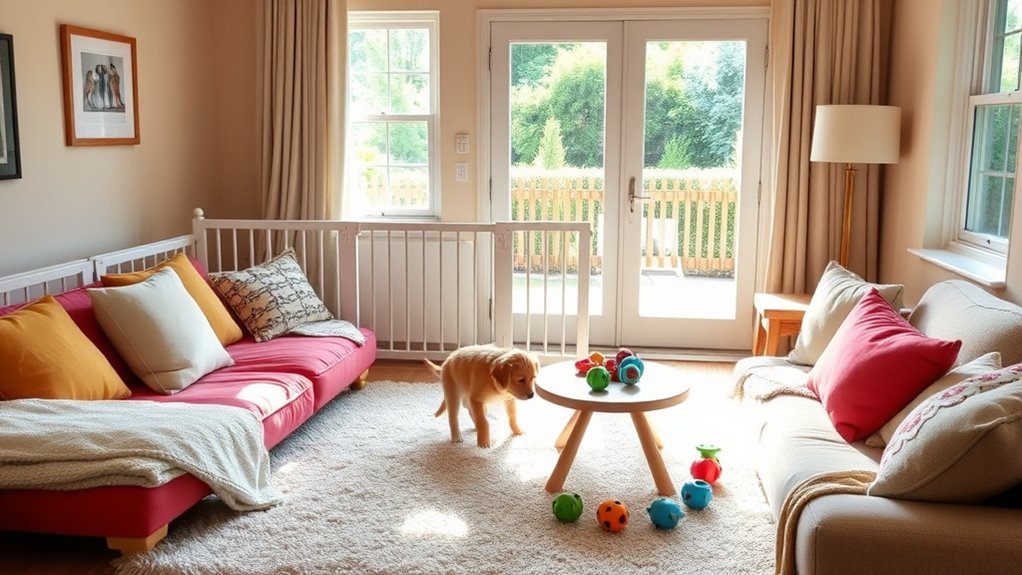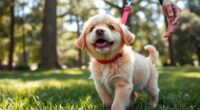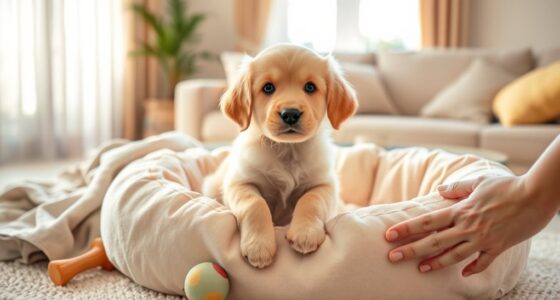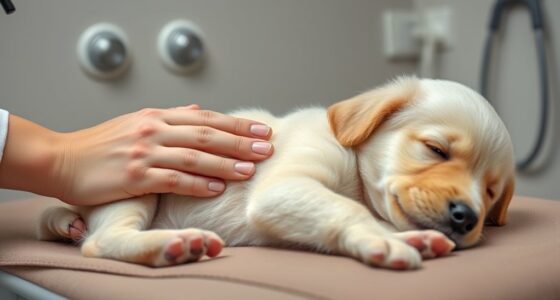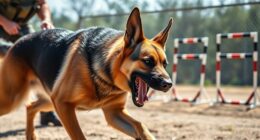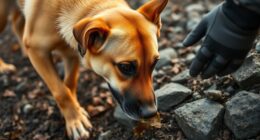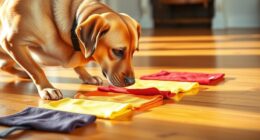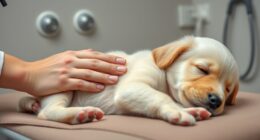To puppy-proof your home, start by removing or securing hazardous items like toxic plants, chemicals, and small objects that pose choking risks. Create a safe space with a crate and designated play zones free of hazards. Use durable, non-toxic toys and rotate them to keep your pup engaged. Block electrical cords and use barriers to limit access to unsafe areas. Maintaining supervision and setting clear boundaries guarantees your little explorer stays safe—discover more tips to keep your puppy protected.
Key Takeaways
- Create designated, hazard-free play zones with secure barriers to limit puppy exploration.
- Store toxic chemicals and small objects out of puppy reach in locked cabinets.
- Use protective covers on electrical cords and hide them to prevent chewing.
- Place crates and bedding in quiet, draft-free areas for safe rest and comfort.
- Regularly supervise interactions and use barriers to restrict access to unsafe spaces.
Securing Hazardous Items and Areas
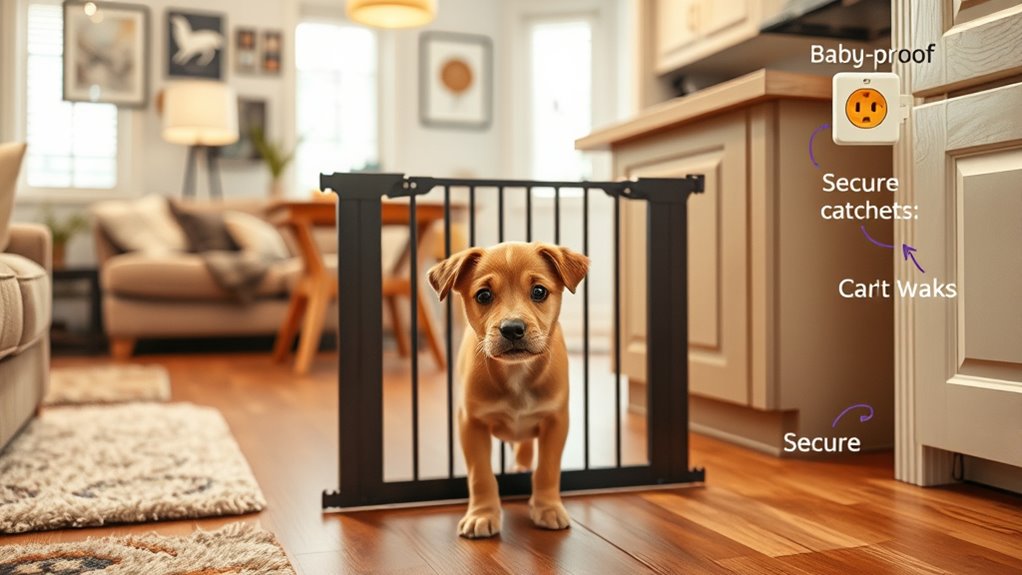
To keep your puppy safe, you need to identify and secure hazardous items and areas around your home. Start by removing or relocating hazardous plants that could be toxic if ingested, such as lilies or azaleas. Be vigilant about storing toxic chemicals like cleaning supplies, antifreeze, and pesticides out of your puppy’s reach. Check cabinets and storage areas regularly to guarantee they’re securely closed. Keep trash cans covered or in locked cabinets to prevent scavenging. Remember, puppies are curious and tend to chew on anything within reach. By proactively eliminating or securing these hazards, you create a safer environment that minimizes the risk of poisoning or injury, giving your puppy the freedom to explore safely. Additionally, incorporating safety standards in your home can further enhance protection for your little explorer. Ensuring your home adheres to vetted safety guidelines can help prevent accidents and create a secure space for your puppy’s growth. Regularly inspecting your home for potential hazards and addressing them promptly can make a significant difference in your puppy’s safety. Implementing safe space zones designated specifically for your puppy can also reduce the likelihood of exposure to dangers. Educating yourself about common household dangers can help you stay vigilant and maintain a safe environment for your puppy.
Creating a Puppy-Friendly Living Space

Creating a puppy-friendly living space involves designing areas that encourage safe exploration and easy supervision. You want your puppy to feel secure while discovering new surroundings, which makes crate training essential. A designated, comfortable crate helps with house training and provides a safe retreat. Use a puppy proofing checklist to identify potential hazards and organize your space accordingly. Consider the layout carefully to minimize obstacles and prevent accidents. For example, selecting safe space elements that are appropriately placed can significantly reduce risks. Incorporating hazard prevention techniques into your setup ensures a safer environment for your little explorer. Additionally, understanding electric bike speeds and their capabilities can inspire you to consider safe, quiet options for outdoor play areas. Choosing the right air quality devices can also improve your puppy’s environment by reducing airborne pollutants and allergens. Here’s a quick overview:
| Safe Space Element | Key Considerations |
|---|---|
| Crate Placement | Quiet, accessible, away from drafts |
| Play Area | Clear of hazards, puppy-proofed |
| Supervision Zones | Keep within sight, minimize escape routes |
This setup ensures your puppy explores confidently while staying safe. Incorporating automation technologies can help monitor your puppy’s activity and alert you to potential issues when you’re not nearby.
Safe Toys and Enrichment Activities
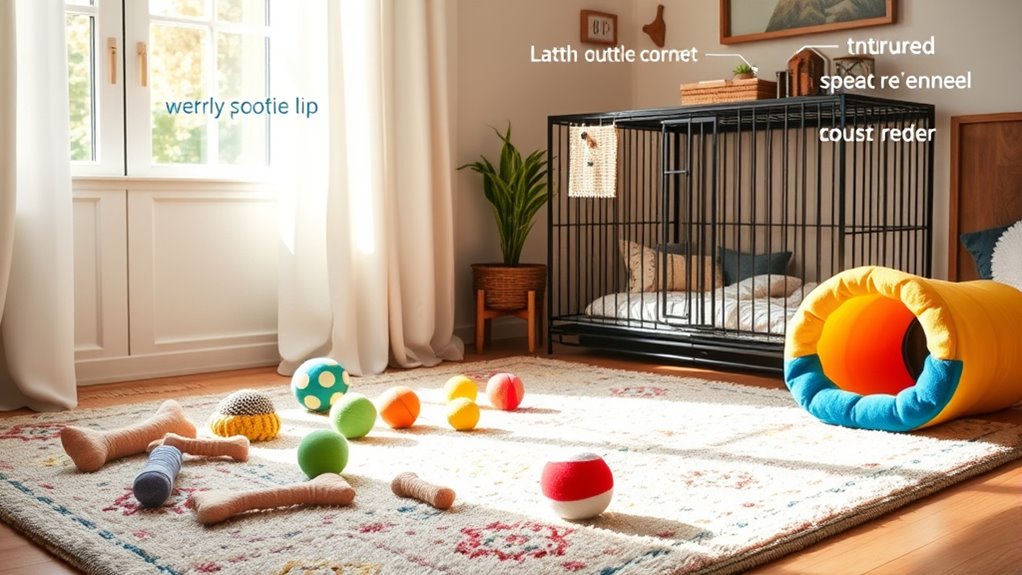
Ensuring your puppy has safe toys and enriching activities is essential for their development and well-being. Providing interactive puzzles keeps their mind engaged and encourages problem-solving skills, which helps prevent boredom. Choose toys made from non-toxic, durable materials that can withstand chewing. Comfortable bedding is also crucial, offering a cozy spot for rest and relaxation after playtime. Rotating toys regularly keeps your puppy interested and stimulates their curiosity. Enrichment activities like scent games or gentle tug-of-war not only entertain but also strengthen your bond. Always supervise playtime to guarantee toys remain safe and intact. By offering a variety of safe toys and activities, you create a stimulating environment that fosters your puppy’s physical and mental growth.
Managing Electrical Cords and Small Objects
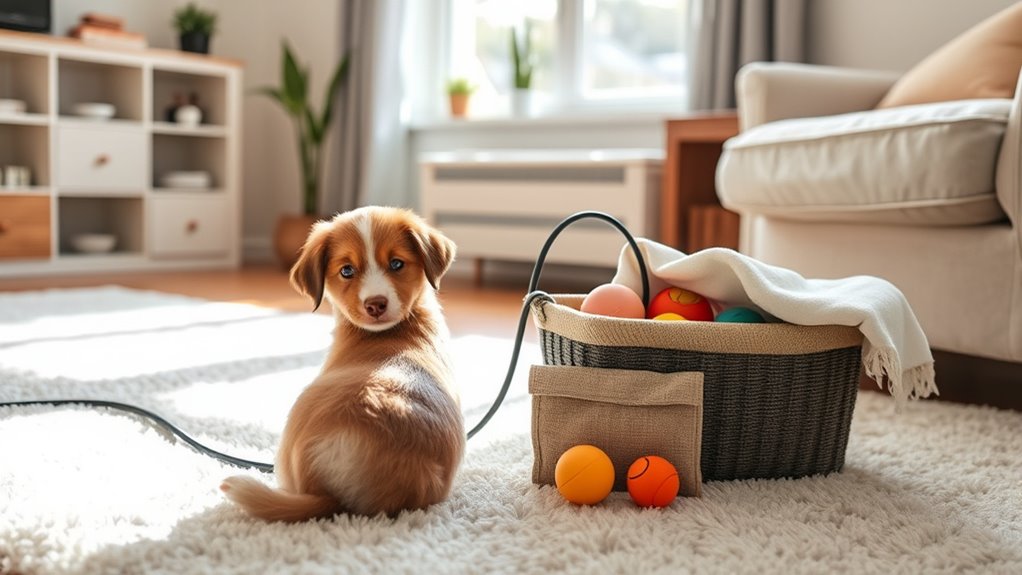
Electrical cords and small objects pose significant risks if left accessible to your puppy. Their natural chewing habits and teething needs can lead them to gnaw on cords or swallow tiny items, risking electrical shock or choking. To prevent accidents, hide or secure cords out of reach, using cord protectors or covers. Keep small objects like coins, jewelry, or toys that could be swallowed off the floor. Providing appropriate teething relief toys can help satisfy your puppy’s desire to chew and reduce the urge to explore harmful items. Regularly inspect your space for hidden dangers, and redirect your puppy’s attention to safe, chewable toys. Using essential oils for teething relief can also soothe your puppy’s gums during the teething process. Staying vigilant guarantees your little explorer stays safe while satisfying their natural chewing instincts.
Establishing Boundaries and Supervision Strategies
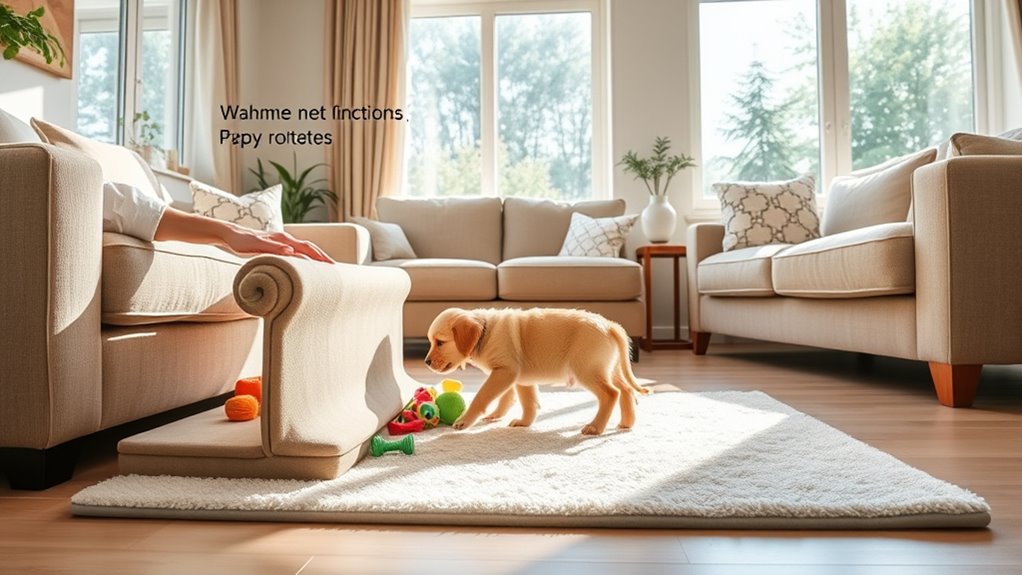
To keep your puppy safe and well-behaved, establishing clear boundaries and consistent supervision is essential from the start. Use physical barriers like baby gates to limit access to unsafe areas and designate designated zones for your puppy to explore. This approach helps with house training by creating predictable spaces and routines. During socialization, supervise interactions with people and other animals, applying socialization techniques to build confidence and prevent fearfulness. Consistent supervision guarantees you can correct unwanted behaviors early, reinforcing boundaries effectively. Set rules and stick to them, so your puppy learns what’s acceptable. Over time, this structured environment promotes good habits, making house training smoother and fostering a well-adjusted, confident dog. Additionally, maximizing space and organization within your home can create a safer environment by reducing hazards and clutter that could pose risks to your puppy. Creating a safe and organized environment also helps prevent accidents and injuries by eliminating potential hazards. Incorporating knowledge about home theater projectors and their features can provide distractions or entertainment during training, making the process more engaging for your puppy. Being aware of vetted safety products can further enhance your puppy-proofing efforts by ensuring you select reliable and effective safety tools. Moreover, understanding decor ideas can help you design a space that is both functional and aesthetically pleasing for your puppy’s comfort.
Frequently Asked Questions
How Can I Puppy-Proof Outdoor Spaces Effectively?
To puppy-proof outdoor spaces, start with fence installation to keep your pup safe and contained. Remove or secure outdoor toys that could be swallowed or cause choking. Check for gaps or weak spots in fences and repair them promptly. Keep harmful plants, chemicals, and trash out of reach. Supervise your puppy during outdoor play and create a designated, secure area where they can explore freely without risks.
What Are Some Non-Toxic Plants Safe for Puppies?
You want to keep your puppy safe, so knowing about non-toxic plants is key. Check out a toxic plant list to identify safe options, focusing on houseplant safety. Some popular non-toxic plants include spider plants, Boston ferns, and African violets. Always verify plant safety before bringing new greenery home. By selecting these safe options, you create a puppy-proof environment that’s both beautiful and secure for your little explorer.
How Do I Puppy-Proof Multi-Story Homes?
Your home’s multi-story layout can feel like a maze, but you can make it safe for your puppy. Start by securing stairs safety with gates at the top and bottom to prevent falls. Cover electrical hazards with cord protectors and hide wires out of reach. Keep tempting objects off the floor and supervise your pup during exploration. With these steps, you’ll turn your house into a puppy-safe paradise!
What Are Recommended Safety Measures for Puppy-Proofing Furniture?
To puppy-proof your furniture, start by using furniture corner protectors to prevent injuries from sharp edges. You should also invest in detachable furniture covers to shield your upholstery from scratches and chewing. Regularly check for loose or fragile parts that your pup might chew on, and keep cords or small objects out of reach. These safety measures help create a safer environment, making your home more comfortable for your little explorer.
How Can I Prevent My Puppy From Escaping the Yard?
Think of your yard as a castle, and your puppy as a curious explorer enthusiastic to escape. To keep them safely inside, start leash training early so they learn boundaries. Use indoor barriers like fences or baby gates to create a fortress around the yard. These tools act as loyal guards, preventing your puppy from slipping away and ensuring they stay safe while discovering their world.
Conclusion
You might think puppy proofing takes too much effort, but it’s worth it to keep your little explorer safe. With a few simple steps, you can create a secure environment that encourages their curiosity while preventing accidents. Remember, a proactive approach now saves you stress and costly vet bills later. So, don’t wait—start puppy proofing today and enjoy the peace of mind knowing your pup can explore safely and happily.

